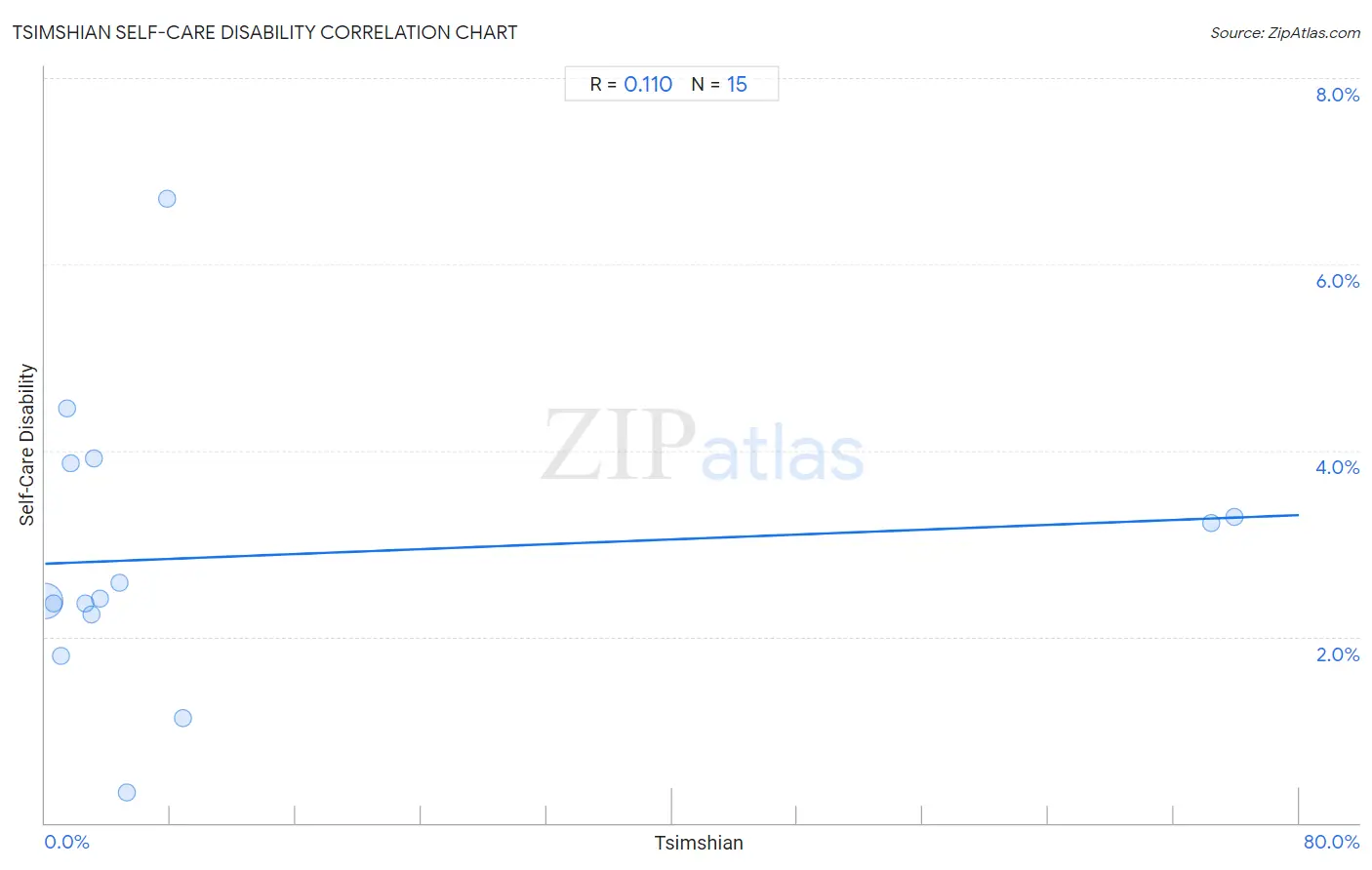Tsimshian Self-Care Disability
COMPARE
Tsimshian
Select to Compare
Self-Care Disability
Tsimshian Self-Care Disability
2.6%
SELF-CARE DISABILITY
0.3/ 100
METRIC RATING
255th/ 347
METRIC RANK
Tsimshian Self-Care Disability Correlation Chart
The statistical analysis conducted on geographies consisting of 15,618,387 people shows a poor positive correlation between the proportion of Tsimshian and percentage of population with self-care disability in the United States with a correlation coefficient (R) of 0.110 and weighted average of 2.6%. On average, for every 1% (one percent) increase in Tsimshian within a typical geography, there is an increase of 0.0065% in percentage of population with self-care disability.

It is essential to understand that the correlation between the percentage of Tsimshian and percentage of population with self-care disability does not imply a direct cause-and-effect relationship. It remains uncertain whether the presence of Tsimshian influences an upward or downward trend in the level of percentage of population with self-care disability within an area, or if Tsimshian simply ended up residing in those areas with higher or lower levels of percentage of population with self-care disability due to other factors.
Demographics Similar to Tsimshian by Self-Care Disability
In terms of self-care disability, the demographic groups most similar to Tsimshian are Immigrants from Central America (2.6%, a difference of 0.020%), Haitian (2.6%, a difference of 0.040%), Immigrants from Haiti (2.6%, a difference of 0.060%), Immigrants from Bangladesh (2.6%, a difference of 0.14%), and Immigrants from Liberia (2.6%, a difference of 0.21%).
| Demographics | Rating | Rank | Self-Care Disability |
| Nicaraguans | 0.6 /100 | #248 | Tragic 2.6% |
| Mexican American Indians | 0.5 /100 | #249 | Tragic 2.6% |
| Portuguese | 0.4 /100 | #250 | Tragic 2.6% |
| Immigrants from Liberia | 0.4 /100 | #251 | Tragic 2.6% |
| Immigrants from Bangladesh | 0.4 /100 | #252 | Tragic 2.6% |
| Immigrants from Haiti | 0.3 /100 | #253 | Tragic 2.6% |
| Haitians | 0.3 /100 | #254 | Tragic 2.6% |
| Tsimshian | 0.3 /100 | #255 | Tragic 2.6% |
| Immigrants from Central America | 0.3 /100 | #256 | Tragic 2.6% |
| Potawatomi | 0.3 /100 | #257 | Tragic 2.6% |
| Nonimmigrants | 0.3 /100 | #258 | Tragic 2.6% |
| Immigrants from Belarus | 0.2 /100 | #259 | Tragic 2.6% |
| Chippewa | 0.2 /100 | #260 | Tragic 2.6% |
| Arapaho | 0.2 /100 | #261 | Tragic 2.6% |
| Shoshone | 0.2 /100 | #262 | Tragic 2.7% |
Tsimshian Self-Care Disability Correlation Summary
| Measurement | Tsimshian Data | Self-Care Disability Data |
| Minimum | 0.024% | 0.32% |
| Maximum | 75.9% | 6.7% |
| Range | 75.8% | 6.4% |
| Mean | 12.9% | 2.9% |
| Median | 3.1% | 2.4% |
| Interquartile 25% (IQ1) | 1.4% | 2.2% |
| Interquartile 75% (IQ3) | 7.8% | 3.9% |
| Interquartile Range (IQR) | 6.3% | 1.6% |
| Standard Deviation (Sample) | 25.4% | 1.5% |
| Standard Deviation (Population) | 24.5% | 1.5% |
Correlation Details
| Tsimshian Percentile | Sample Size | Self-Care Disability |
[ 0.0% - 0.5% ] 0.024% | 15,398,370 | 2.4% |
[ 0.5% - 1.0% ] 0.53% | 170,082 | 2.4% |
[ 0.5% - 1.0% ] 0.99% | 15,580 | 1.8% |
[ 1.0% - 1.5% ] 1.41% | 3,609 | 4.5% |
[ 1.5% - 2.0% ] 1.62% | 804 | 3.9% |
[ 2.5% - 3.0% ] 2.53% | 1,736 | 2.4% |
[ 2.5% - 3.0% ] 2.92% | 822 | 2.2% |
[ 3.0% - 3.5% ] 3.10% | 838 | 3.9% |
[ 3.0% - 3.5% ] 3.46% | 13,913 | 2.4% |
[ 4.5% - 5.0% ] 4.77% | 8,168 | 2.6% |
[ 5.0% - 5.5% ] 5.18% | 656 | 0.32% |
[ 7.5% - 8.0% ] 7.76% | 361 | 6.7% |
[ 8.5% - 9.0% ] 8.79% | 546 | 1.1% |
[ 74.0% - 74.5% ] 74.40% | 1,465 | 3.2% |
[ 75.5% - 76.0% ] 75.85% | 1,437 | 3.3% |